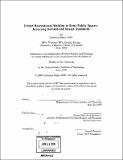| dc.contributor.advisor | Susan Silberberg-Robinson. | en_US |
| dc.contributor.author | Duffy, Catherine Marie | en_US |
| dc.contributor.other | Massachusetts Institute of Technology. Dept. of Urban Studies and Planning. | en_US |
| dc.date.accessioned | 2009-11-06T16:21:29Z | |
| dc.date.available | 2009-11-06T16:21:29Z | |
| dc.date.copyright | 2009 | en_US |
| dc.date.issued | 2009 | en_US |
| dc.identifier.uri | http://hdl.handle.net/1721.1/49697 | |
| dc.description | Thesis (M.C.P.)--Massachusetts Institute of Technology, Dept. of Urban Studies and Planning, 2009. | en_US |
| dc.description | Includes bibliographical references (p. 147-153). | en_US |
| dc.description.abstract | Encouragement and facilitation of walking for health and community benefits has recently become an important focus in the city planning and public health fields. Urban design guidelines have increasingly highlighted pedestrian transportation and recreation as important elements for community design. Although various techniques to increase walking such as crime prevention, traffic calming and streetscape improvements have been employed in cities and towns across North America, cold, icy and snowy weather conditions as well as other factors prevent many individuals from walking year round. This thesis identifies indoor walking spaces and programs as a potential supplement to outdoor walking spaces, discusses challenges and opportunities offered by these spaces and programs and highlights potential contributions to the community-building and public realm design. An assessment of demand for indoor walking programs and a review of best practices for implementation is presented through interviews with walkers, planners, planners, architects and health professionals across the United States and Canada. The results of these interviews reveal the existence of an interest in indoor walking, especially among retired senior citizens. In general, walkers are not particular about the aesthetic design of the places available for indoor walking, but stress the importance of having access to a reliable place to walk and a need for social interaction. | en_US |
| dc.description.abstract | (cont.) Discussions with space/program providers and additional research allow reveal the challenges inherent in creating indoor walking programs and offer potential solutions for implementation. Awareness of walker preferences and common program challenges can help planners determine locations for indoor walking programs and appropriate policy interventions in order to both increase the number of walkers throughout the year and enhance connectedness and pedestrian activity in communities. | en_US |
| dc.description.statementofresponsibility | by Catherine Marie Duffy. | en_US |
| dc.format.extent | 153 p. | en_US |
| dc.language.iso | eng | en_US |
| dc.publisher | Massachusetts Institute of Technology | en_US |
| dc.rights | M.I.T. theses are protected by
copyright. They may be viewed from this source for any purpose, but
reproduction or distribution in any format is prohibited without written
permission. See provided URL for inquiries about permission. | en_US |
| dc.rights.uri | http://dspace.mit.edu/handle/1721.1/7582 | en_US |
| dc.subject | Urban Studies and Planning. | en_US |
| dc.title | lndoor recreational walking in semi-public spaces : assessing demand and design standards | en_US |
| dc.type | Thesis | en_US |
| dc.description.degree | M.C.P. | en_US |
| dc.contributor.department | Massachusetts Institute of Technology. Department of Urban Studies and Planning | |
| dc.identifier.oclc | 436233081 | en_US |
